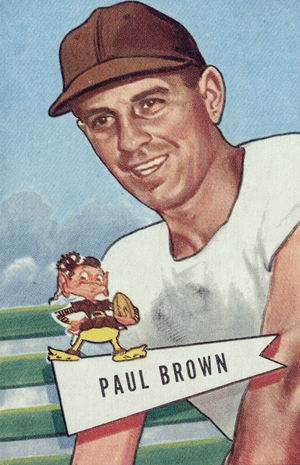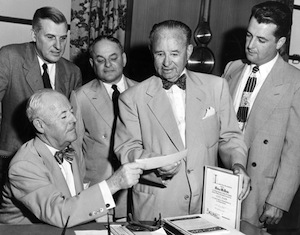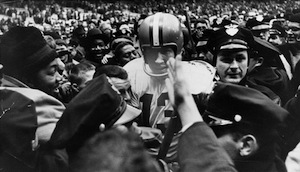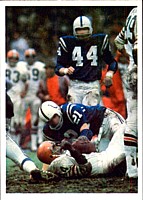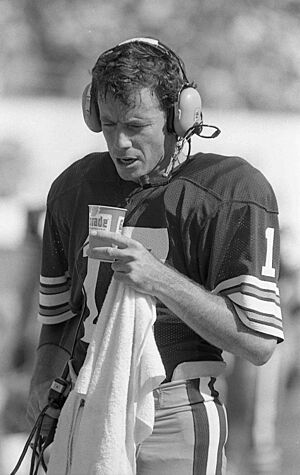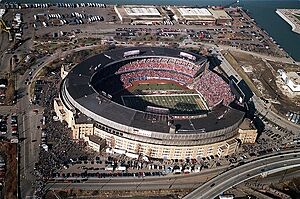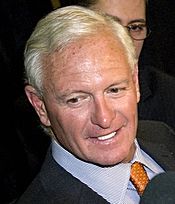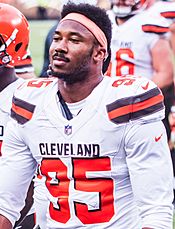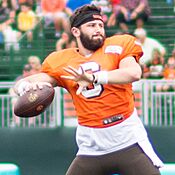History of the Cleveland Browns facts for kids
The history of the Cleveland Browns American football team began in 1944. That's when Arthur B. "Mickey" McBride got a team in the new All-America Football Conference (AAFC) for Cleveland, Ohio. Paul Brown, a famous coach, gave the team its name and was its first coach.
From the start in 1946, the Cleveland Browns were very successful. They won all four AAFC championships before the league ended in 1949. The team then joined the National Football League (NFL). They kept winning there too! From 1950 to 1955, Cleveland played in the NFL championship game every year, winning three times.
McBride sold the team in 1953. Later, in 1961, Art Modell bought the team. Modell fired Paul Brown in 1963. But the team still won with star player Jim Brown. The Browns won the NFL championship in 1964. They also reached the title game in 1965. The team made the playoffs many times in the late 1980s. But they never reached the Super Bowl.
When the AFL and NFL joined together in 1970, Cleveland became part of the new American Football Conference (AFC). The Browns made the playoffs in 1971 and 1972. But then they had some tough years. In 1979 and 1980, quarterback Brian Sipe led many exciting last-minute wins. Fans called them the "Kardiac Kids". However, they didn't get past the first round of the playoffs.
Later, quarterback Bernie Kosar led the team to three AFC Championship games in the late 1980s. But they lost each time. In 1995, Modell announced he was moving the Browns to Baltimore. This made Cleveland fans very upset. After talks and legal fights, Modell moved the team. But Cleveland got to keep the Browns' name, colors, and history. After a break of three years, the Browns started playing again in 1999. This was under new owner Al Lerner. Since then, the Browns have made the playoffs only three times.
The Browns are one of only 12 NFL teams that existed before 1960.
Contents
- Early Success and AAFC Championships (1946–1949)
- Joining the NFL and Continued Success (1950–1956)
- The Jim Brown Era and New Owners (1957–1965)
- Playoff Challenges (1966–1973)
- The "Kardiac Kids" Era (1974–1984)
- The Bernie Kosar Years and Heartbreaking Losses (1985–1990)
- The Belichick Era and Modell's Move (1991–1995)
- Preparing for the Browns' Return (1996–1998)
- The Browns Return to the NFL (1999–2003)
- Long Playoff Drought and Many Changes (2003–2020)
- Return to Success and Playoffs (2020–Present)
- See also
Early Success and AAFC Championships (1946–1949)
In 1944, a sports editor named Arch Ward suggested a new football league. It was called the All-America Football Conference (AAFC). It would compete with the NFL after World War II. Arthur B. "Mickey" McBride, a Cleveland businessman, became an owner for the Cleveland team.
McBride wanted a great coach. He asked a sportswriter for ideas. The writer suggested Paul Brown, the 36-year-old coach of the Ohio State Buckeyes. McBride followed this advice in 1945. He made Brown the head coach. Brown had a great record coaching high school and college teams.
The team's name was first left to Brown. He didn't want it to be called the Browns. So, McBride held a contest in May 1945. "Cleveland Panthers" was the most popular choice. But Brown said no. He didn't want a name from an earlier team that failed. In August, McBride decided to name the team the Browns. This was despite Paul Brown's wishes.
For years, Paul Brown sometimes said the team was named "Brown Bombers". This was after the boxer Joe Louis, who was called "The Brown Bomber". He said it was shortened to "Browns". But later, Brown admitted he made up this story. He didn't want the team named after him. Today, the Browns and the NFL say the team was named after Paul Brown.
As the war ended, the team started building its roster. They signed Otto Graham, a star quarterback. They also signed kicker Lou Groza and receivers Dante Lavelli and Mac Speedie. Marion Motley and Bill Willis, two of the first African-Americans in pro football, joined in 1946.
The Browns' first game was on September 6, 1946. They played the Miami Seahawks at Cleveland Municipal Stadium. The Browns won 44–0. This started a time of great success. With Paul Brown leading, the team won all four AAFC championships from 1946 to 1949. Their record was 52 wins, four losses, and three ties. In 1948, the Browns became the first team in pro football history to have a perfect season.
The Browns were great on defense. But their offense was also amazing. They used Paul Brown's "T formation". This style focused on speed and teamwork. Brown liked his players "lean and hungry". Graham became a star quarterback. Motley was the AAFC's top rusher. Brown and six players from these early years later joined the Pro Football Hall of Fame.
Cleveland fans loved the Browns from the start. The NFL's Cleveland Rams had moved to Los Angeles. So the Browns were the only pro football team in the city. Their success made them even more popular. But the Browns became too good. Their dominance showed that other AAFC teams weren't as strong. This led to the AAFC ending. Three of its teams, including the Browns, joined the NFL in 1949.
Joining the NFL and Continued Success (1950–1956)
When Cleveland joined the NFL in 1950, everyone wondered if they could keep winning. The Browns' first NFL game was against the defending champions, the Philadelphia Eagles. Cleveland won 35–10. This showed everyone how good the Browns were.
With Graham, Groza, Motley, and Lavelli, Cleveland finished the 1950 season with a 10–2 record. They won a playoff game against the New York Giants. Then they played the Los Angeles Rams in the NFL championship game. The Browns won 30–28 with a last-minute kick by Groza. Fans rushed the field to celebrate.
After five straight championships, the Browns aimed for another in 1951. They finished 11–1. But they lost the championship rematch to the Rams, 24–17. This was their first loss in a championship game.
In 1952 and 1953, Cleveland reached the championship game again. But they lost both times to the Detroit Lions. Even with these losses, the team was still strong. Players like Len Ford and Ray Renfro became stars.
In 1953, the Browns' original owners sold the team for $600,000. A group of Cleveland businessmen bought it.
Before the 1954 season, star quarterback Otto Graham said he would retire. Other key players also left. But Cleveland still finished 9–3. They met Detroit in the championship game for the third time. This time, Cleveland won big, 56–10. Graham threw three touchdowns and ran for three more.
Cleveland's success continued in 1955. Paul Brown convinced Graham to play one more year. The Browns finished 9–2–1. They won their third NFL championship, beating the Los Angeles Rams 38–14. This was Graham's last game. He had led his team to the championship game every year for 10 years.
Without Graham, the Browns struggled in 1956. They had their first losing season, 5–7. Many original players retired. During this time, Paul Brown tested a helmet with a radio inside. This let him talk to his quarterback during games. The NFL banned the device in 1956. But today, all NFL teams use in-helmet radios.
The Jim Brown Era and New Owners (1957–1965)
In 1957, the Browns needed new talent. They drafted fullback Jim Brown from Syracuse University. In his first season, Brown led the NFL in rushing yards. He was named rookie of the year. Cleveland finished 9–2–1. They reached the championship game again. But they lost badly to Detroit, 59–14.
In 1958, the Browns relied more on running the ball. Jim Brown ran for a record 1,527 yards. Cleveland finished 9–3. But they lost a key game to the New York Giants. This kept them out of the championship.
The 1959 and 1960 seasons were okay. Jim Brown kept leading the league in rushing. But behind the scenes, Paul Brown and Jim Brown had problems. Jim Brown didn't like his coach's strict rules.
Art Modell Buys the Team
In 1960, the Browns' owner, Dave Jones, wanted to sell the team. Art Modell, a 35-year-old advertising executive, bought the team in March 1961 for $3.925 million. Modell promised that Paul Brown would still lead the team.
The 1961 season was typical. Jim Brown led the league in rushing again. The team finished 8–5–1. But players started to question Paul Brown's strict style. They talked to Modell, who was closer to their age.
More problems grew between Paul Brown and Modell in 1962. Brown made a trade without telling Modell. He traded star player Bobby Mitchell for the rights to Ernie Davis. Davis was a college star. He was the first African-American to win the Heisman Trophy. Davis signed with the Browns. But he became very sick and was diagnosed with leukemia. Brown said Davis couldn't play that season. Modell thought Davis could play. This caused more tension between them. Davis sadly passed away the next May.
The disagreements between Brown and Modell grew. The team finished 7–6–1 in 1962. Jim Brown did not lead the league in rushing that year.
Paul Brown is Fired
On January 9, 1963, Art Modell announced that Paul Brown was no longer the coach. This was a big shock. Brown had been a key figure in Cleveland sports for 17 years. He was known for many new ideas in football. He was the first coach to call plays for his quarterback. He also used game film to study opponents. Jim Brown praised him for helping integrate the game.
Modell named Blanton Collier, Brown's assistant, as the new head coach. Collier was friendly and smart. Players liked him. He let the quarterback call plays. In Collier's first season, the Browns finished 10–4. Jim Brown won the MVP award with a record 1,863 rushing yards.
1964 Championship Victory
Cleveland returned to the top in 1964 with a 10–3–1 record. Jim Brown led the league in rushing again. Rookie receiver Paul Warfield was also a star. The Browns went into the championship game as underdogs against the Baltimore Colts. Most experts thought the Colts would win easily.
But the Browns' coach, Collier, studied the Colts carefully. He changed the Browns' defense. This strategy worked. In the windy Cleveland Municipal Stadium, the Browns beat the Colts 27–0. Neither team scored in the first half. But in the second half, the Browns' defense held strong. Quarterback Frank Ryan threw three touchdowns to Gary Collins. The Browns won their first title since 1955. Collins was named the game's MVP.
This was the last time any Cleveland professional sports team won a major title until 2016. It remains the last NFL title for the Browns.
The next year, 1965, was also strong. Jim Brown had another great rushing season. The Browns finished 11–3. They played the Packers in the NFL Championship game. The Packers won 23–12. After this season, the NFL and AFL agreed to merge. This led to the Super Bowl era.
Playoff Challenges (1966–1973)
In early 1966, Jim Brown was filming a movie in London. Delays meant he would miss training camp. Modell threatened to fine him. Brown, who had thought about retiring, announced he was leaving football. He held records for most rushing yards in a game, season, and career.
With Brown gone, Leroy Kelly became the main rusher. Cleveland missed the playoffs in 1966. But they made it in 1967. They lost to the Dallas Cowboys. After 21 seasons, kicker Lou Groza, the last original Brown, retired in 1968.
More playoff losses followed. In 1968, the Browns lost to the Colts. In 1969, they lost to the Minnesota Vikings. When the NFL and AFL merged in 1970, the Browns joined the new AFC. They were in the AFC Central division. Paul Brown had started a new team, the Cincinnati Bengals, in the AFL.
The Browns started the 1970 season by winning the first-ever Monday Night Football game. They beat the New York Jets. The next month, Cleveland played Paul Brown's Bengals for the first time. The Browns won. But the season ended 7–7.
Coach Blanton Collier retired in 1970. Nick Skorich took over. In 1971, the team improved to 9–5. But they lost in the playoffs. In 1972, quarterback Mike Phipps became the starter. The Browns finished 10–4. They played the undefeated Miami Dolphins in the playoffs. Cleveland led in the fourth quarter. But the Dolphins scored late and won 20–14. This kept the Dolphins' perfect season alive. In 1973, the Browns finished 7–5–2.
The "Kardiac Kids" Era (1974–1984)
The mid-1970s were a time of change for the Browns. Many older star players retired. In 1974, the Browns had only their second losing season ever, 4–10. Quarterback Mike Phipps struggled. Rookie quarterback Brian Sipe also played. Modell fired coach Skorich.
Forrest Gregg became the new coach. He wanted a tough, physical team. But the Browns started with their worst losing streak ever. They finished 3–11 in 1975. The team improved in 1976, finishing 9–5. They missed the playoffs. Sipe became the starting quarterback.
In 1977, Sipe got hurt. Modell asked Gregg to resign. Modell then hired Sam Rutigliano as head coach. Rutigliano was a friendly and calm coach. Sipe played well under him. In 1978, Sipe threw for 21 touchdowns. The Browns finished 8–8.
The Kardiac Kids
Rutigliano was a coach who liked to take risks. This style showed on the field in 1979. The season started with a close overtime win against the New York Jets. Rutigliano joked that his heart couldn't take it. In the second week, Cleveland won another close game against the Kansas City Chiefs. The third game was a 13–10 win against the Baltimore Colts. A sportswriter called them the "Kardiac Kids" because of all the exciting, close finishes.
The late-game heroics continued. The Browns won an overtime game against the Miami Dolphins. A columnist wrote that you shouldn't watch Browns games if you have a weak heart. The Browns finished 9–7. They didn't make the playoffs. But there was a lot of excitement around the team.
The "Kardiac Kids" magic returned in 1980. More close games followed. The team won on the last play against Green Bay. After more close wins, the Browns finished with an 11–5 record.
"Red Right 88"
This good record earned the Browns a playoff spot. They played the Oakland Raiders on January 4, 1981. It was very cold in Cleveland. The game was close. Cleveland led 12–7 in the third quarter. But the Raiders scored to go up 14–12. With 2:22 left, Cleveland had one last chance.
Sipe led the offense down the field. They reached Oakland's 14-yard line with 56 seconds left. A short field goal would win the game. But Rutigliano decided to go for a touchdown. He called a play called "Red Right 88". Sipe threw the ball. But an Oakland player intercepted it. The Raiders won. This play became known as "Red Right 88". It became a symbol of Cleveland's playoff struggles.
Despite the loss, people expected the Browns to be even better in 1981. But the "Kardiac Kids" magic was gone. Sipe threw many interceptions. The team finished 5–11. The 1982 season was shortened by a strike. The Browns finished 4–5. They made the playoffs but lost to the Raiders again.
In 1983, Sipe played well. But the team just missed the playoffs. Sipe then left to play in another league.
In 1984, player Hanford Dixon started calling the defensive linemen "the Dogs". This name stuck. Fans started wearing face paint and dog masks. The section of fans in the bleachers became known as the "Dawg Pound". It's still a symbol of loyal Browns fans.
Without Sipe, the Browns' offense struggled in 1984. Fans were frustrated. Modell fired coach Rutigliano. Marty Schottenheimer took over. The team finished 5–11.
The Bernie Kosar Years and Heartbreaking Losses (1985–1990)
The Browns drafted quarterback Bernie Kosar in 1985. This started a new, successful time for the team. With Schottenheimer, Kosar, and talented players, the Browns reached new heights. They became regular playoff teams. But they never reached the Super Bowl. They lost three times in the AFC Championship game.
Kosar wanted to play for Cleveland because his family lived nearby. He signed a big contract in 1985. He quickly became a fan favorite. Kosar led the team to an 8–8 record. Running backs Earnest Byner and Kevin Mack also ran for over 1,000 yards each.
The Browns won their division in 1985. They played the Miami Dolphins in the playoffs. Cleveland led at halftime. But the Dolphins came back and won 24–21.
In 1986, the Browns became one of the NFL's top teams. Kosar played even better. The defense was strong. Cornerbacks Frank Minnifield and Hanford Dixon were a great duo. The Browns finished 12–4. They had home-field advantage in the playoffs.
The Browns' first playoff game in 1986 was against the New York Jets. The Jets led late in the game. But Cleveland scored a touchdown. Then the defense forced a punt. With less than a minute left, the offense got into field goal range. Kicker Mark Moseley tied the game with 11 seconds left. The game went into double overtime. Moseley then made a field goal to win it for the Browns, 23–20. It was their first playoff win in 17 years.
The Drive
The next week, the Browns played the Denver Broncos in the AFC Championship game. Denver took an early lead. But Cleveland tied the game and then went up 20–13 in the fourth quarter. With 5:32 left, the Broncos started at their own 2-yard line. Denver quarterback John Elway then led a 98-yard drive for a touchdown. This drive, known as "The Drive", tied the game.
The game went into overtime. Cleveland got the ball first. But their offense was stopped. On Denver's first turn, Elway led another long drive. It ended with a field goal that won the game for Denver. "The Drive" is seen as one of the best drives in playoff history. For Cleveland fans, it's remembered as a heartbreaking loss.
Even after this loss, Cleveland kept winning in 1987. The defense was excellent. The Browns finished 10–5. They won their division again. In the playoffs, they beat the Indianapolis Colts 38–21.
The Fumble
This set up another rematch with the Broncos in the AFC Championship. Denver led 21–3 at halftime. But Cleveland fought back. They scored to get within seven points. Denver scored again to go up by seven with four minutes left. Kosar and the offense reached Denver's 8-yard line. Kosar handed the ball to Earnest Byner. Byner ran towards the end zone. But a Denver player stripped the ball just before he scored. This play became known as "The Fumble". The Broncos won 38–33.
The 1988 season had many injuries to Browns quarterbacks. But Cleveland still finished 10–6. They made the playoffs. They lost to the Houston Oilers. After the loss, coach Schottenheimer left the team. Bud Carson became the new coach.
In 1989, Kosar led Cleveland to a 9–6–1 record. They won their division. They beat the Pittsburgh Steelers 51–0 in the first game. Cleveland survived a close playoff game against the Buffalo Bills. This set up a third AFC Championship game against the Broncos. Denver led the whole game and won 37–21.
This loss was the end of Cleveland's playoff streak in the late 1980s. In 1990, the defense struggled. Kosar threw more interceptions than touchdowns. The team started 2–7. Carson was fired. Jim Shofner was interim coach. The team finished 3–13. After the season, Bill Belichick became the new head coach.
The Belichick Era and Modell's Move (1991–1995)
Belichick's Time as Coach
Bill Belichick became the Browns' coach in 1991. He was known for being tough with the media. He tried to change the Browns into a strong, cold-weather team. But his new ideas didn't bring immediate success. Cleveland finished 6–10 in 1991. Kosar played well, but the team struggled. Kosar broke his ankle twice in 1992. The team finished 7–9.
By 1992, Belichick saw that Kosar was not as strong as before. Kosar was Cleveland's most popular player. But Belichick wanted to make a change. The team brought in Vinny Testaverde. In 1993, Belichick benched Kosar during a game. Testaverde led a comeback win. Two weeks later, Testaverde became the starter.
Kosar returned briefly after Testaverde got hurt. But then the team cut Kosar. Belichick said it was because his skills were declining. Fans were very upset. They burned their season tickets. Cleveland won only two games after Kosar left. They finished 7–9 again.
Cleveland improved in 1994. The defense was the best in the league. The Browns finished 11–5. They made the playoffs for the first time in five years. They beat the Patriots in a playoff game. But their rival, Pittsburgh, won 29–9 in the next round. This ended the Browns' season.
Modell Moves the Team to Baltimore
Even with success in 1994, owner Art Modell had money problems. He had a deal to lease Cleveland Municipal Stadium. But lawsuits and borrowing caused him trouble.
Modell wanted to leave Cleveland. He met with officials from Baltimore about moving the Browns.
The city of Cleveland immediately sued to stop the move. Fans were very angry. They protested and signed petitions. Advertisers stopped working with the team. Talks continued as the Browns finished the 1995 season 5–11. At the team's last home game, upset fans threw things onto the field.
In February, the different groups reached a deal. Modell could move his team to Baltimore. But Cleveland would keep the Browns' name, colors, and history. A new Browns team would start playing in Cleveland by 1999. Modell's team later became the Baltimore Ravens. The Browns were officially paused by the NFL from 1996 to 1998.
Preparing for the Browns' Return (1996–1998)
Plans for the Browns' return began after the agreement. The NFL created the Cleveland Browns Trust in 1996. They hired Bill Futterer to lead it. His job was to market the team and sell tickets. He also helped with building a new stadium.
Demolition of the old stadium began in November 1996. The new stadium started being built in May 1997.
As the stadium was built, the NFL looked for a new owner. Many people wanted to buy the team. The winner was Al Lerner, a banking executive. He bought the team for $530 million in September 1998. Carmen Policy was hired to run the football side of things.
The Browns Trust promoted the team's return. They used Hall of Famers like Lou Groza and Jim Brown. Lerner and Policy hired Dwight Clark as operations director. Then they hired Chris Palmer as the new head coach in January 1999. The NFL held an expansion draft to get players for the new Browns team. The Browns also got the first pick in the 1999 draft. They used it to draft quarterback Tim Couch.
The new stadium was finished in August 1999. This meant Cleveland could host football again.
The Browns Return to the NFL (1999–2003)
Fans had high hopes for the new team. But as a new team, the Browns had to build their roster from scratch. They used rookies and players other teams didn't want. The Browns struggled. They lost their first game 43–0 to the Steelers. They finished 2–14 in 1999. In 2000, they finished 3–13. Coach Palmer was fired in 2001.
Butch Davis, a college coach, was hired as the new head coach. Davis had turned around the University of Miami's football team. Policy and Lerner hoped he could do the same for the Browns.
Butch Davis Era: 2001–2004
The Browns improved under Davis. They almost made the playoffs in 2001. But a controversial call in a game against Jacksonville ended their chances. Fans threw plastic bottles onto the field. This event was called "bottlegate". The game was stopped and later finished with no fans. The Browns finished 7–9.
Cleveland improved again in 2002. But owner Al Lerner passed away in October 2002. His son, Randy Lerner, took over the team. Cleveland finished 9–7. They made the playoffs as a wild-card team. Quarterback Tim Couch broke his leg. So backup Kelly Holcomb started the playoff game against the Steelers. Cleveland led for most of the game. But Pittsburgh came back and won 36–33. This was the Browns' only playoff appearance since 1999 until 2020.
Long Playoff Drought and Many Changes (2003–2020)
The team's progress stopped in 2003. The Browns finished 5–11. Randy Lerner made many changes in the front office. Coach Davis resigned in November 2004. The team finished 4–12.
In 2005, Phil Savage was hired as general manager. A month later, Romeo Crennel became the head coach. Crennel was the defensive coordinator for the Super Bowl champion New England Patriots. The Browns acquired veteran quarterback Trent Dilfer. They also drafted wide receiver Braylon Edwards.
The team started 2–2 in 2005. But they finished 6–10. Rookie Charlie Frye became the starting quarterback late in the season. Cleveland finished 4–12 in 2006.
In 2007, the Browns returned to being contenders. They traded Frye and put Derek Anderson in as the starter. Anderson led the Browns to a surprise 51–45 win. The Browns finished 10–6. They tied for first in their division. But they missed the playoffs because of tie-breaking rules. Six players were chosen for the Pro Bowl.
Expectations were high for 2008. But Cleveland finished last in their division, 4–12. Anderson shared starts with other quarterbacks. The team struggled. Near the end of the season, there were issues with players getting infections. In November, general manager Savage had a public argument with a fan. After the season, Lerner fired Savage and Crennel.
New Management: 2009–2011
The Browns hired Eric Mangini as head coach in 2009. The team traded tight end Kellen Winslow Jr.. The Browns showed little improvement in Mangini's first year, finishing 5–11.
At the end of 2009, Lerner hired former Packers coach Mike Holmgren as team president. A month later, Tom Heckert became general manager. Mangini returned for a second season.
Under Holmgren and Heckert, the Browns changed their quarterbacks. They traded Brady Quinn and released Derek Anderson. They acquired Jake Delhomme and Seneca Wallace. They also drafted quarterback Colt McCoy. Running back Peyton Hillis had a great season, rushing for 1,177 yards. But the Browns finished 5–11 again. Mangini was fired in January 2011.
Pat Shurmur became the new head coach. He had helped develop quarterbacks before. Holmgren and Heckert hoped he could do the same with McCoy. The team started 2–1. But McCoy struggled. The Browns finished 4–12. During this season, a frustrated fan made a video calling the stadium a "Factory of Sadness". This nickname stuck.
In 2012, the Browns drafted running back Trent Richardson and quarterback Brandon Weeden. Weeden was expected to replace McCoy.
On September 6, 2012, former owner Art Modell passed away. The Browns planned a moment of silence. But his family asked them not to, knowing how fans felt. Weeden started the first game. The Browns lost 17–16.
In July 2012, owner Randy Lerner announced he would sell the Browns to businessman Jimmy Haslam. The sale was final in October 2012. Haslam became the new owner. The next day, Joe Banner was named CEO.
The Browns lost their first five games in 2012. This was an 11-game losing streak. They beat the Bengals in October. On December 31, 2012, coach Shurmur and general manager Heckert were fired.
More Changes: 2013–2015
The Browns hired Rob Chudzinski as head coach in January 2013. The stadium was renamed FirstEnergy Stadium. Michael Lombardi became the new general manager. The Browns finished 4–12 in 2013. Chudzinski was fired after only one year.
On January 24, 2014, the Browns hired Mike Pettine as head coach. Ray Farmer replaced Lombardi as general manager. In the 2014 draft, the Browns picked cornerback Justin Gilbert and quarterback Johnny Manziel.
In 2014, the Browns started using a live dog named "Swagger" as their mascot. On October 5, 2014, the Browns made a huge comeback. They were down 28–3 against the Tennessee Titans. But they scored 26 unanswered points to win 29–28. This was the biggest comeback by a road team in NFL history. The Browns started 7–4. But they lost their last five games. They finished 7–9.
In 2015, the NFL suspended general manager Ray Farmer for four games. This was because he texted the coaching staff during games. The team also unveiled new uniforms. They featured "Cleveland" on the front and "Dawg Pound" inside the collar.
The Browns finished 3–13 in 2015. They lost 10 of their last 11 games. After the season, Ray Farmer and Mike Pettine were fired.
More Struggles: 2016–2019
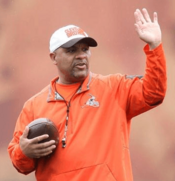
In January 2016, the Browns hired Sashi Brown as executive vice president. They also hired Paul DePodesta as chief strategy officer. These moves showed the Browns were trying a new, data-focused way to build the team.
On January 13, 2016, the Browns hired Hue Jackson as head coach. He was the eighth head coach since the team returned in 1999. On March 11, quarterback Johnny Manziel was released. On March 24, the Browns signed quarterback Robert Griffin III.
The Browns traded down in the 2016 draft. They picked wide receiver Corey Coleman. The 2016 season started with the Browns losing their first 14 games. This was a team record 17-game losing streak. On December 24, the Browns beat the San Diego Chargers 20–17. This was called "The Christmas Miracle". The Browns lost their last game. They finished 1–15. This was the worst record in team history at the time. They got the #1 pick in the 2017 NFL Draft. They picked Myles Garrett.
In 2017, Sashi Brown was fired. John Dorsey became general manager. The Browns finished the 2017 season with an 0–16 record. They were only the second team in NFL history to do this. This gave them the #1 pick again in the 2018 NFL Draft. They picked quarterback Baker Mayfield.
The Browns started the 2018 season with Tyrod Taylor as quarterback. They tied their first game 21–21. This ended their losing streak. Two weeks later, Mayfield came into a game after Taylor got hurt. Mayfield led a comeback win against the New York Jets. This ended the Browns' 19-game winless streak. Jackson named Mayfield the starter.
After a 2–5–1 record, Hue Jackson was fired. Gregg Williams became interim head coach. The Browns won five of their last eight games. They finished 7–8–1. Mayfield had a great rookie season.
In January 2019, Freddie Kitchens was named head coach. In March 2019, the Browns acquired star receiver Odell Beckham Jr. and pass rusher Olivier Vernon. These moves raised expectations for the Browns. Many thought they could be Super Bowl contenders.
But the 2019 season was a disaster. The Browns struggled with penalties and discipline. They finished 6–10. Kitchens was fired. General manager John Dorsey also left the team.
Return to Success and Playoffs (2020–Present)
Stefanski Era: 2020–Present
After Kitchens and Dorsey left, owner Jimmy Haslam hired Kevin Stefanski as head coach in January 2020. He also hired Andrew Berry as general manager. At 32, Berry became the youngest general manager in NFL history.
The Browns added many new players for Stefanski's offense. They signed Jack Conklin and Austin Hooper. They drafted left tackle Jedrick Wills. The 2020 season started with a loss. But the team won its next four games. This was their first four-game winning streak since 2009. The Browns finished 11–5. They made the playoffs for the first time since 2002.
Several players received awards. Running back Nick Chubb, guard Joel Bitonio, and defensive end Myles Garrett made the Pro Bowl. Kevin Stefanski was named NFL Coach of the Year.
On January 10, 2021, the Browns won their first playoff game since 1995. They beat the Pittsburgh Steelers 48–37. Baker Mayfield played well in his playoff debut. On January 17, the Browns lost to the defending Super Bowl champion Kansas City Chiefs. But the Browns received praise for their big turnaround in 2020.
The Browns worked on improving their defense in 2021. They signed safety John Johnson III and defensive end Jadeveon Clowney. They also drafted new players. The 2021 season started with a loss to the Chiefs. Quarterback Baker Mayfield suffered a shoulder injury. He played through it but struggled. This affected the offense. The Browns finished 8–9 and missed the playoffs.
In 2022, the Browns traded for four-time Pro Bowl receiver Amari Cooper. They also traded for quarterback Deshaun Watson. Watson was suspended for 11 games. So Jacoby Brissett started for the Browns. The Browns won their first game against the Carolina Panthers. Rookie kicker Cade York made a game-winning field goal. This was the Browns' first win in a season opener since 2004.
In Week 1 of the 2023 season, the Browns won their first home opener since 2004. They beat the Bengals 24–3. On December 17, the Browns secured their fourth winning season since 1999. The team finished 11–6. They made the playoffs. But they lost to the Houston Texans in the first round, 45–14.
As of 2024, the Browns and Detroit Lions are the only two NFL teams that have played in 58 seasons of the Super Bowl era but have never reached the Super Bowl.
See also
- History of Cleveland
- List of Cleveland Browns seasons



